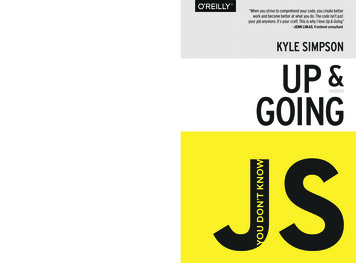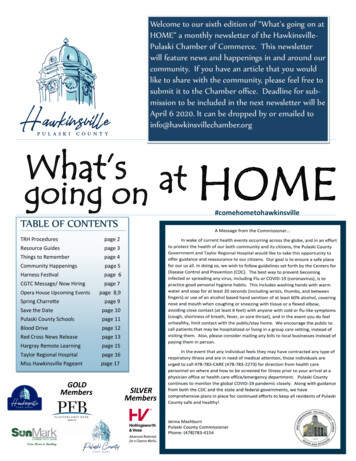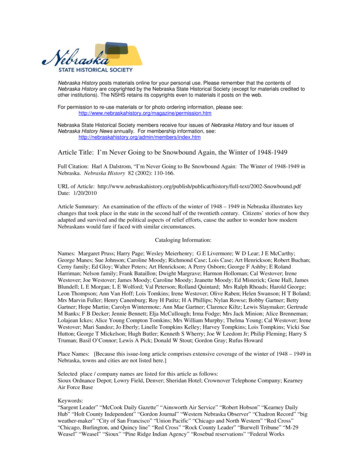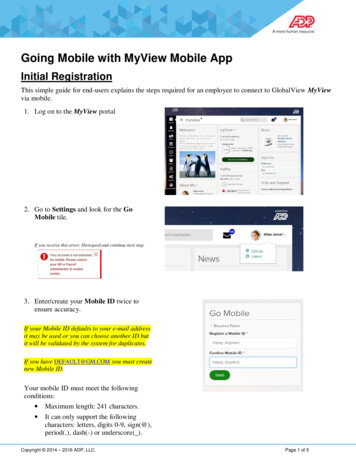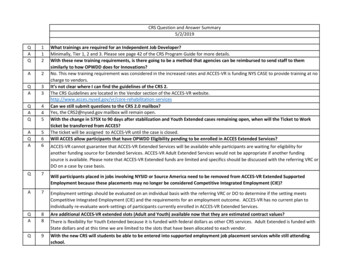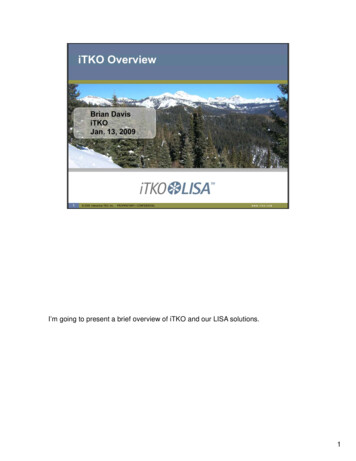
Transcription
I’m going to present a brief overview of iTKO and our LISA solutions.1
iTKO was founded in 1999 to Enable SOA agility and quality. Yes service orientedconceptst havehbbeenaroundd sinceieven priori tto ththatt titime andd we hhave bbeen iin ththebusiness of helping companies like these reap the rewards of service-basedarchitectures since then. Our product was launched commercially in early 2003.Customers come to us to help succeed specifically in SOA, but others come toprovide virtualization of legacy systems, or provide quality and continuous validationfor their ESB initiative,, and other reasons.From here, just identify with the customer’s similarity to another customer 2
Today’s applications are getting more and more complex. SOA, ESB, Compositeapplications,li tianddNN-tieredti d architectureshit tallll contributet ib t tto thithis ttechnically.h i ll ThThebusiness drivers of M&A, automating business partner transactions, BPM, andoutsourcing cause the business to need more interconnectedness & speed ofdelivery.It follows that as you increase the complexity of your environment and hold all otherg constant yyour qqualityy will suffer.thingsTo avoid this, most organizations have to slow their pace of change, threateningtheir agility goals for business agility3
By adopting best practices and technology support that is enlightened to thechallengesh lloff agilityilit andd qualitylit on complexl systems,twe can iimprove ththese thithingsand bring down costs. We can also increase our development throughput andtherefore revenue to the business.What I’d like to do is introduce you to to some of the issues standing in the way ofAgility and Quality, then show you some best practices and tooling to resolve them.4
Here are some of the common pitfalls that need to be addressed sothat you can enable agility & quality and decrease the cost.(now just name them)5
Strategy: The 4C’sQuality & Agility for Complex EnvironmentsComplete & Collaborative Testingtest single componentstage of the lifecyclequality for all technologies, everyContinuous ValidationPhased tests constant validation ofbusiness processes and servicesConstraint VirtualizationEliminate dependenciesresources, and dataparallel development, sharedWe have been doing this a long time, and we have been working with customers foryears on how to get these service-based architectures to deliver on their intended value.We have distilled that domain expertise into a best practices framework we call the4-C’s for Quality and Agility.My assertion to you is that if you get these concepts into your strategy you willdramatically increase your chances of success.This is true regardless of how, but of course I’d like to ‘cut to commercial’ asI discuss each of these areas to address how our product LISA can helpyou accomplish thesethese.At a high level, you can see there are 3 areas of concern, Testing, Validation,and Virtualization. These are the enablers for Quality and Agility.Name the C’s if you want, but DO NOT describe them here!!!6
Complete testing simply acknowledges the fact that we are in a heterogeneousenvironment and that this causes our test strategy to become equally heterogeneous.It is no longer safe to simply assume that we can test at the UI of an application andassume all is well. We may not even have a human interface at all – it might be amachine interface like a web service we need to test.Yet we can’t simplify the problem to any one layer like the web services layer either.We have to understand that our not complete unless they can invoke logic at onetechnology layer then verify at a deeper level. We call this “invoke and verify”.Without this we are implicitly trusting the very system we are testing.For example at a Bank ATM, you might 1) make a deposit, 2) look at receipt, 3) butthe receipt is not sufficient to prove outcome, 4) must verify “around” the ATM at themainframe or call center app or something to ensure that the balance was actuallycredited to your account.You won’t be surprised to hear that LISA is really good at this. Our technologycoverage is unmatched. We cover all the commonly used standards in service-basedarchitectures and have native integration with most J2EE servers and ESBsESBs. Ourextensibility is strong and helps us cover even your proprietary technologies so thattestability issues can be resolved.7
Here is an example of testing a business process modelmodel. To do this LISA is used toinvoke the business process, then verify the expected outcomes. Invoking might beusing a UI, making a web service call, putting a document on an ESB, or even droppinga file into a drop-box folder.Verification is equally heterogeneous Did the ERP system get the order messagewith the right customer data?Did the customer billing system see the update?Did the shipping queue get its message?8
Collaborative is our next C. It acknowledges the fact that enabling agility requiresmore parallelism and shared effort and data in our delivery teams. To do this we needtests that start from development and can be shared through the lifecycle. Thatmeans unit or service type tests can be consumed by QA, QA can iterate on thosetests and bounce back failing scenarios. Appropriate tests can be used asperformance tests. And even into integration and production.The other area in which we must collaborate better is to provide visibility. Just like wemodel business processes with sub-processes to encapsulate,encapsulate we need the samething here. This way QA and business analysts are not expected to understand everytechnical nuance of these complex systems and yet they wield a lot of testing poweron them.9
Here’s an example of a customer that has the classic “Complete & Collaborative”testing problem.Robotting at the UI was not helping them uncover the issues in their system thatwere occurring within the Message bus and underlying systems over a period ofmonths. All of the contributing teams of these heterogeneous technologies need tobe involved.(listen to the story)10
The 3rd of our C strategy is Continuous ValidationValidation. We must acknowledge thefact that systems can no longer be ignored from a quality point of view once deployed.If we do, we threaten quality and therefore agility as unintended consequenceswill catch us off guard.If you have time, give the plumbing analogyHere’s scenario:The service in the picture below were developed in support of App 1 11
Then a new application 2 arrives and starts consuming some of those same services.In support of this, existing services are reused and some are enhanced.Sounds like we are winning on this whole SOA thing!12
But OUCH, once App 2 hits production App1 is now failing. After taking way too longto realize, the App 1 team realizes that a data service is no longer working as expected.So guess who’s upset? But wait, the data service wasn’t even changed! So it turns outthat an internal service used by the data service is now subtly different.That difference is causing an upstream failure.13
But OUCH, once App 2 hits production App1 is now failing. After taking way too longto realize, the App 1 team realizes that a data service is no longer working as expected.So guess who’s upset? But wait, the data service wasn’t even changed! So it turns outthat an internal service used by the data service is now subtly different.That difference is causing an upstream failure.14
Our goal here is to take some of the concepts your developers may have embracedaround Continuous Integration and continue them throughout the lifecycle. The veryreason you need it at build time is why you need it at the point of staging, in yourintegration labs, in partner development labs, and even in production.To support this LISA provides build-time support for Junit and Ant natively. This waywe hook into the build-time continuous process.But there is no existing mechanism anywhere else, so for integration and productionwe provide our own infrastructure we call the Continuous Validation Service15
A leading high-tech firm planned a very ambitious project to improve the usabilityand performance of its market-facing website within a 6 month time frame.It was quickly determined that running a small suite of use case tests, and manualtesting, wouldn’t provide enough test coverage of structural, functional andperformance attributes to ensure that the multi-tier system could handle 1000 concurrent users, as well as supportUsing LISA, the development and testing teams created a suite of more than 1200tests that are run automatically every night, and within 4 weeks the team hasachieved more than 95% coverage of their application.In addition the team has LISA continuously validating key customer scenarios every5 minutes to ensure that as systems in the US, China, India and Europe arecontinuing to handle user traffic and transactions accurately and within ServiceLevel Agreements.All of the continuous test data and alerts are then fed from LISA server into thecompany’s IT Operations solution database for continuous monitoring.As of now, the system has had no serious downtime problems in the last year,thanks to having such a strong set of regression testing and early warnings ofperformance issues.16
Our 4th C is maybe the one most responsible for agility-robbing friction indevelopment cycles.(read the bullets word for word)Constraint virtualization is essentially an acknowledgement that we must eliminatethe constraints present in our dependencies. I’ll use an example to illustrate 17
We are building or changing this “source application”, and we call out to 3 differentsystems. From the bottom up, the MF requires no changes to support ourapplication, but we have restricted access to it. I’ve heard from customers that theyonly get 2 hours a day of access for example. So how do we develop ourapplication with such constrained access?The database doesn’t belong to us, and we need a few new stored procedures forour application to function.function So great,great I now have a months-long negotiation anddevelopment cycle to wait until that database is ready for my use. I’m dead in thewater until then. How can I work now when a dependent system isn’t ready for me?And finally, the web service I will invoke is still under development. Someoperations work, and some don’t. The best part is it’s a day-by-day prognosis!Some days I hear that “hey the ERP guys latest build is broken” and my team issuddenly stopped until the other team clears the error.I have a scope and a date to deliver to, but how can I with these constraints?18
The answer is to virtualize the behavior of these systems. I don’t mean server/hardware virtualization.Th t’ greatt andThat’sd use it.it ButB t you can’t’t createt a VMWareVMWimageioff a mainframe.i fYouY can’t’t stabilizet bili a webbservice by imaging it.But you can image the behavior of these systems, or model their future behavior.Take that mainframe you don’t have access to, image it’s behavior, and you can host that image in avirtual environment that allows 24/7 scalable access.Image that database, then modify the image, not the real DB, so you have the future state of thedatabase. This allows you to start work immediately.And for the web service, you can access either the live service or our virtual service as needed. As weshow above, you can even do so from UDDI queries to bind you to the desired service endpointdynamically.Now that you have a strategy for eliminating these dependencies you are in control of your deliverydestiny.Our product that performs this magic is called LISA Virtualize. It contains a server called the virtualizeservice environment, or VSE, that is used to host your service images. This maps exactly to the servervirtualization you do with VMWare or Citrix.In those products you image a whole hard disk, then deploy that image into a virtual environment thatknows how to run them. We do ppreciselyy the same typeyp of activity,y, onlyy at the service behavior level.In cooperation, you have a completely virtualized, de-coupled development, test, performance testingenvironment.19
Procure to Pay: In this test scenario, LISA is acting as a supplier. A purchase Orderis created in R/3, which is configured to send a message to XI on order creationusing iDOC adaptor. SAP R/3 Native iDOC is converted to iDOC XML, which is thenmapped into Supplier XML and sent to the supplier as a one-way web-service call.In the scenario, LISA is acting as a supplier. LISA gets the asynchronous message(using LISA VSE), parses the data and sends N number of PO confirmations basedon number of items.Here LISA is invoking one-way WS into XI. When XI gets PO-Confirmation, it mapsit into outgoing iDOC XML and then hand it over to iDOC adaptor, so that theconfirmation can be delivered to the SAP R/3.20
So those are the 4-C’s. Again we are convinced that good strategy for quality & agilityin SOA is based on these principles.And as I’ve discussed along the way, LISA is a great way to provide the technologysupport for this strategy.(describe each product briefly)An important point to make here finally is that this is actually one frameworkthat is delivered in 3 personalities. It’s one download and dbl-click install.You can get one license of LISA that does everything on this slide. Or you canlicense just our virtualization or continuous validation capabilities, for example.21
OPTIONALLISA will play nicely with others. Most of the time that’s HP Test Director for QC andLoadRunner. Sometimes it’s also Junit tests. Either way, we are not here to ripand-replace what’s already working. We will fit into what you are already doing welland make you better at these new areas of concern.We are cooperative with other tools in most of our accountsaccounts. It’sIt s only those who arenot succeeding with existing tools or have no tools that adopt LISA for every facet.Integrate with HP/Mercury’s Test Director for Quality CenterBi-directional link to load test info from LISA, execute from TD for QCIntroduce TD to an Agile/CI Process, Also supports leading ALM tools22
And finally it’s important for you as a company to know that we are working withthe same partners that you have partnered with. Many of our technology partnersare actually customers first. That shows you how strong LISA is and how muchwe are committed to those platforms.Many of you will have one or many SI partners. We are strategic partners with mostof them.23
So to wrap up, I introduced this whole notion around complexity taking awayour quality and/or agility. I mentioned 3 specific areas of concern that are shown here.Then I introduced you to our 4-C’s strategy to solve for these issues.LISA is uniquely capable of delivering on the 4-C’s.(OK guys, it’s up to you now ;)24
Jan 13, 2009 · Here is an example of testing a business process model To do this LISA is used toHere is an example of testing a business process model. To do this LISA is used to invoke the business process, then verify the expected outcomes. Invoking might be using a UI, making a web service

